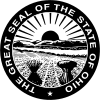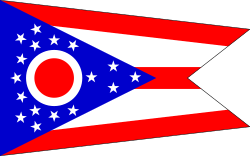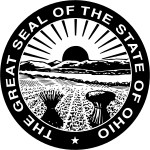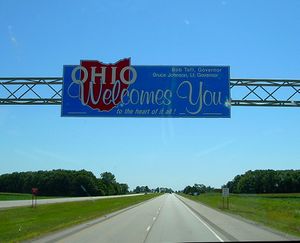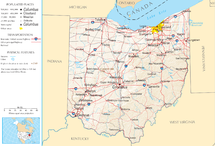أوهايو
أوهايو | |
|---|---|
| ولاية أوهايو | |
| الكنية: The Buckeye State; Birthplace of Aviation; The Heart of It All | |
| الشعار: | |
| النشيد: Beautiful Ohio (1969)[2] Hang On Sloopy (1985)[3] | |
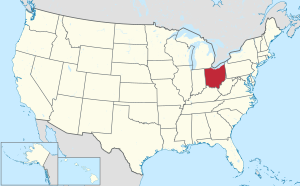 خريطة الولايات المتحدة، موضح فيها أوهايو | |
| البلد | الولايات المتحدة |
| انضمت للاتحاد | March 1, 1803[4] (17th, declared retroactively on August 7, 1953[5]) |
| العاصمة (وأكبر مدينة) | Columbus[6][7] |
| أكبر منطقة عمرانية | Greater Cleveland (Combined and urban) Cincinnati (metro) Columbus (metro) (see footnotes)[أ] |
| الحكومة | |
| • الحاكم | Mike DeWine (R) |
| • نائب الحاكم | Jon Husted (R) |
| المجلس التشريعي | General Assembly |
| • المجلس العلوي | Senate |
| • المجلس السفلى | House of Representatives |
| القضاء | Supreme Court of Ohio |
| سناتورات الولايات المتحدة | Sherrod Brown (D) J.D. Vance (R) |
| وفد مجلس النواب | 10 Republicans 5 Democrats (القائمة) |
| المساحة | |
| • الإجمالي | 44٬825 ميل² (116٬096 كم²) |
| • البر | 40٬948 ميل² (106٬156 كم²) |
| • الماء | 3٬877 ميل² (10٬040 كم²) 8.7% |
| ترتيب المساحة | 34th |
| الأبعاد | |
| • الطول | 220 mi (355 km) |
| • العرض | 220 mi (355 km) |
| المنسوب | 850 ft (260 m) |
| أعلى منسوب | 1٬549 ft (472 m) |
| أوطى منسوب | 455 ft (139 m) |
| التعداد (2021) | |
| • الإجمالي | 11٬780٬017 [9] |
| • الترتيب | 7th |
| • الكثافة | 282/sq mi (109/km2) |
| • ترتيب الكثافة | 10th |
| • الدخل الأوسط للأسرة | $54٬021[10] |
| • ترتيب الدخل | 36th |
| صفة المواطن | Ohioan; Buckeye[11] (colloq.) |
| اللغة | |
| • اللغة الرسمية | De jure: None De facto: English |
| • اللغة المحكية | English 93.3% Spanish 2.2% Other 4.5%[12] |
| منطقة التوقيت | UTC– 05:00 (Eastern) |
| • الصيف (التوقيت الصيفي) | UTC– 04:00 (EDT) |
| اختصار البريد | OH[13] |
| ISO 3166 code | US-OH |
| الاختصار التقليدي | O., Oh. |
| خط العرض | 38°24′ N to 41°59′ N |
| خط الطول | 80°31′ W to 84°49′ W |
| الموقع الإلكتروني | ohio |
أوهايو Ohio هي ولاية امريكية تقع في الغرب الأوسط للولايات المتحدة، يحدها من الشمال بحيرة إيري وولاية مشيگن، شرقي ولاية إنديانا، غربي ولاية پنسلفانيا، وشمال ولايتي وست فرجينيا وكنتكي. رمزها البريدي هو OH في النظام الامريكي. أوهايو هي كلمة في لغة قبيلة الإيروكوي الهندية وتعني الماء العظيم، وترجع تسمية الولاية بهذا الاسم نسبة إلى نهر اوهايو الذي يمثل حدودها الجنوبية.
عدد السكان في الولاية 11,353,140 نسمة في احصاءات عام 2000.
ولاية في المنطقة الغربية الوسطى من الولايات المتحدة، وهي إحدى الولايات الصناعية الرئيسية. ساعد وجود المياه الوفيرة وخام المعدن في أراضيها والموقع المركزي على جعلها منطقة صناعية مهمة. كذلك نمت أوهايو كولاية زراعية حيث تمتد فيها الأراضي الزراعية الخصبة التي تكوّن جزءا من حزام القمح الكبير في المنطقة الغربية الوسطى.
ولد سبعة من رؤساء الولايات المتحدة بالولاية (التي تسمي نفسها أم الرؤساء) وعاصمة أوهايو هي كولمبس. وقد كونت الأنهار الجليدية معظم أراضي أوهايو منذ آلاف السنين. ويتدفق نهر أوهايو على امتداد الحدود الجنوبية والجنوبية الشرقية للولاية.
| ||||||||||||||||||||||||||||||||||||||||||||
Ohio takes its name from the Ohio River, which in turn originated from the Seneca word ohiːyo', meaning "good river", "great river", or "large creek".[14][15] The state arose from the lands west of the Appalachian Mountains that were contested from colonial times through the Northwest Indian Wars of the late 18th century. It was partitioned from the resulting Northwest Territory, which was the first frontier of the new United States, becoming the 17th state admitted to the Union on March 1, 1803, and the first under the Northwest Ordinance.[4][16] Ohio was the first post-colonial free state admitted to the union and became one of the earliest and most influential industrial powerhouses during the 20th century. Although it has transitioned to a more information- and service-based economy in the 21st century, it remains an industrial state, ranking seventh in GDP اعتبارا من 2019[تحديث],[17] with the third-largest manufacturing sector and second-largest automobile production.[18]
The government of Ohio is composed of the executive branch, led by the governor; the legislative branch, consisting of the bicameral Ohio General Assembly; and the judicial branch, led by the state Supreme Court. Ohio occupies 16 seats in the United States House of Representatives.[19] The state is known for its status as both a swing state and a bellwether in national elections.[20] Seven presidents of the United States have come from Ohio. This has led to it receiving the moniker "the Mother of Presidents".[21]
التاريخ
ملخص
عندما وصل أوائل المستوطنين البيض كانت تعيش في المنطقة قبائل متعددة. أدى نزاع فرنسا وبريطانيا على أراضٍ في شمال أمريكا بما في ذلك إقليم أوهايو، إلى الحرب الفرنسية الهندية (1754-1763م) وبعد الحرب تنازلت فرنسا عن مطالبتها بأوهايو.
وقد باشرت الولايات المتحدة السيطرة على الإقليم بعد الثورة الأمريكية (1775-1783م) وأصبحت أوهايو ولاية في 1 مارس عام 1803م.
أدت التجارة على نهر أوهايو وقنواته والسكك الحديدية المقامة هناك إلى ازدهار الحالة الاقتصادية في الإقليم.
أُسست مشاريع تحكُّم في الفيضانات بعد أن عانت أوهايو من فيضانات مدمرة عام 1913م. بدأت تجارة أوهايو العالمية في النمو في الستينيات من القرن العشرين بعد أن أصبحت ثمان من مدن أوهايو على بحيرة إيري موانئ على ممر سانت لورنس البحري. وفي الثمانينيات أجبر تدني أسعار المحاصيل والماشية العديد من صغار مزارعي أوهايو على ترك العمل.
استقرار السكان الأصليين
Archeological evidence of spear points of both the Folsom and Clovis types indicate that the Ohio Valley was inhabited by nomadic people as early as 13,000 BC.[22] These early nomads disappeared from Ohio by 1,000 BC.[22] Between 1,000 and 800 BC, the sedentary Adena culture emerged. The Adena were able to establish "semi-permanent" villages because they domesticated plants, including sunflowers, and "grew squash and possibly corn"; with hunting and gathering, this cultivation supported more settled, complex villages.[23] The most notable remnant of the Adena culture is the Great Serpent Mound, located in Adams County, Ohio.[23]
Around 100 BC, the Adena evolved into the Hopewell people who were also mound builders. Their complex, large and technologically sophisticated earthworks can be found in modern-day Marietta, Newark, and Circleville.[24] They were also a prolific trading society, their trading network spanning a third of the continent.[25] The Hopewell disappeared from the Ohio Valley about 600 AD. The Mississippian culture rose as the Hopewell culture declined. Many Siouan-speaking peoples from the plains and east coast claim them as ancestors and say they lived throughout the Ohio region until approximately the 13th century.[26]
There were three other cultures contemporaneous with the Mississippians: the Fort Ancient people, the Whittlesey focus people[26] and the Monongahela Culture.[27] All three cultures disappeared in the 17th century. Their origins are unknown. The Shawnees may have absorbed the Fort Ancient people.[26] It is also possible that the Monongahela held no land in Ohio during the Colonial Era. The Mississippian culture was close to and traded extensively with the Fort Ancient people.

Indians in the Ohio Valley were greatly affected by the aggressive tactics of the Iroquois Confederation, based in central and western New York.[28] After the Beaver Wars in the mid-17th century, the Iroquois claimed much of the Ohio country as hunting and, more importantly, beaver-trapping ground. After the devastation of epidemics and war in the mid-17th century, which largely emptied the Ohio country of indigenous people[محل شك] by the mid-to-late 17th century, the land gradually became repopulated by the mostly Algonquian. Many of these Ohio-country nations were multi-ethnic (sometimes multi-linguistic) societies born out of the earlier devastation brought about by disease,[مطلوب توضيح] war, and subsequent social instability. They subsisted on agriculture (corn, sunflowers, beans, etc.) supplemented by seasonal hunts. By the 18th century, they were part of a larger global economy brought about by European entry into the fur trade.[29]
Some of the indigenous nations which historically inhabited Ohio included the Iroquoian,[ت] the Algonquian[ث] and the Siouan.[ج][30][31] Ohio country was also the site of Indian massacres, such as the Yellow Creek massacre, the Gnadenhutten massacre and the Enoch Brown school massacre.[32] After the War of 1812, when Natives suffered serious losses such as at Tippecanoe, most Native tribes either left Ohio or had to live on only limited reservations. By 1842, all remaining Natives were forced out of the state.[33]
الفترتان الاستعمارية والثورية
During the 18th century, the French set up a system of trading posts to control the fur trade in the region. Beginning in 1754, the Kingdom of France and Kingdom of Great Britain fought in the French and Indian War, with various Native American tribes on each side. As a result of the Treaty of Paris, the French ceded control of Ohio and the remainder of the Old Northwest to Great Britain in 1763.[34]
Prior to the American Revolution, Britain thinly exercised sovereignty over Ohio Country by lackadaisical garrisoning of the French forts.[ح] Just beyond Ohio Country was the great Miami capital of Kekionga which became the center of British trade and influence in Ohio Country and throughout the future Northwest Territory. By the Royal Proclamation of 1763, British lands west of Appalachia were forbidden to settlement by colonists.[35] The Treaty of Fort Stanwix in 1768 explicitly reserved lands north and west of the Ohio as Native lands.[36] British military occupation in the region contributed to the outbreak of Pontiac's War in 1763.[37] Ohio tribes participated in the war until an armed expedition in Ohio led by Colonel Henry Bouquet brought about a truce. Another colonial military expedition into the Ohio Country in 1774 brought Lord Dunmore's War, kicked off by the Yellow Creek massacre in Ohio, to a conclusion. In 1774, Britain passed the Quebec Act that formally annexed Ohio and other western lands to the Province of Quebec in order to provide a civil government and to centralize British administration of the Montreal-based fur trade.[38] The prohibition of settlement west of the Appalachians remained, contributing to the American Revolution.[39]
By the start of the American Revolutionary War, the movement of Natives and Americans between the Ohio Country and thirteen colonies had resulted in tension. Fort Pitt in Pennsylvania had become the main fort where expeditions into Ohio started. Intrusions into the area included General Edward Hand's 1778 movement of 500 Pennsylvania militiamen from Fort Pitt towards Mingo towns on the Cuyahoga River, where the British stored military supplies which they distributed to Indian raiding parties;[40] Colonel Daniel Brodhead's invasion in 1780 and destruction of the Lenape Indian capital of Coshocton;[41] a detachment of one hundred of George Rogers Clark's troops that were ambushed near the Ohio River by Indians led by Joseph Brant in the same year; a British and Native American attack on the U.S.' Fort Laurens;[42] and the 1782 detainment and murder of 96 Moravian Lenape pacifists by Pennsylvania militiamen in the Gnadenhutten massacre.[43][44]
The western theatre never had a decisive victor. In the Treaty of Paris in 1783, Britain ceded all claims to Ohio Country to the new United States after its victory in the American Revolutionary War.[45][46]
الإقليم الشمالي الغربي
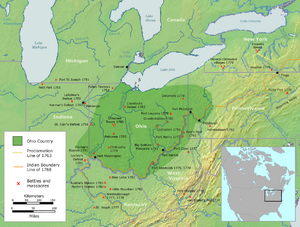
The United States created the Northwest Territory under the Northwest Ordinance of 1787.[47] Slavery was not permitted in the new territory. Settlement began with the founding of Marietta by the Ohio Company of Associates, which had been formed by a group of American Revolutionary War veterans. Following the Ohio Company, the Miami Company (also referred to as the "Symmes Purchase") claimed the southwestern section, and the Connecticut Land Company surveyed and settled the Connecticut Western Reserve in present-day Northeast Ohio. Territorial surveyors from Fort Steuben began surveying an area of eastern Ohio called the Seven Ranges at about the same time.
The old Northwest Territory originally included areas previously known as Ohio Country and Illinois Country. As Ohio prepared for statehood, the Indiana Territory was created, reducing the Northwest Territory to approximately the size of present-day Ohio plus the eastern half of the Lower Peninsula of Michigan and the eastern tip of the Upper Peninsula and a sliver of southeastern Indiana called "The Gore".
The coalition of Native American tribes, known as the Western Confederacy, was forced to cede extensive territory, including much of present-day Ohio, in the Treaty of Greenville in 1795.
Under the Northwest Ordinance, areas could be defined and admitted as states once their population reached 60,000. Although Ohio's population was only 45,000 in December 1801, Congress determined that it was growing rapidly enough and accelerated the process via the Enabling Act of 1802. In regards to the Leni Lenape natives, Congress decided that 10,000 acres on the Muskingum River in the present state of Ohio would "be set apart and the property thereof be vested in the Moravian Brethren ... or a society of the said Brethren for civilizing the Indians and promoting Christianity".[48]
روفوس پتنم، "أبو أوهايو"

Rufus Putnam served in important military capacities in both the French and Indian War and the American Revolutionary War. He was one of the most highly respected men in the early years of the United States.[49]
In 1776, Putnam created a method of building portable fortifications, which enabled the Continental Army to drive the British from Boston. George Washington was so impressed that he made Putnam his chief engineer. After the war, Putnam and Manasseh Cutler were instrumental in creating the Northwest Ordinance, which opened up the Northwest Territory for settlement. This land was used to serve as compensation for what was owed to Revolutionary War veterans. Putnam organized and led the Ohio Company of Associates, who settled at Marietta, Ohio, where they built a large fort called Campus Martius.[50][51][52] He set substantial amounts of land aside for schools. In 1798, he created the plan for the construction of the Muskingum Academy (now Marietta College). In 1780, the directors of the Ohio Company appointed him superintendent of all its affairs relating to the settlement north of the Ohio River. In 1796, he was commissioned by President George Washington as Surveyor-General of United States Lands. In 1788, he served as a judge in the Northwest Territory's first court. In 1802, he served in the convention to form a constitution for the State of Ohio.[53][54][55]
Statehood and early years
On February 19, 1803, U.S. President Thomas Jefferson signed an act of Congress that approved Ohio's boundaries and constitution.[56] However, Congress had never passed a formal resolution admitting Ohio as the 17th state. Although no formal resolution of admission was required, when the oversight was discovered in 1953, as Ohio began preparations for celebrating its sesquicentennial, Ohio congressman George H. Bender introduced a bill in Congress to admit Ohio to the Union retroactive to March 1, 1803, the date on which the Ohio General Assembly first convened.[57] At a special session at the old state capital in Chillicothe, the Ohio state legislature approved a new petition for statehood which was delivered to Washington, D.C., on horseback, and approved that August.[57][58][59]
Ohio has had three capital cities: Chillicothe, Zanesville, and Columbus. Chillicothe was the capital from 1803 to 1810. The capital was then moved to Zanesville for two years, as part of a state legislative compromise to get a bill passed. The capital was then moved back to Chillicothe, which was the capital from 1812 to 1816. Finally, the capital was moved to Columbus, to have it near the geographic center of the state.
Although many Native Americans had migrated west to evade American encroachment, others remained settled in the state, sometimes assimilating in part. Starting around 1809, the Shawnee pressed resistance to encroachment again. Under Chief Tecumseh, Tecumseh's War officially began in Ohio in 1811. When the War of 1812 began, the British decided to attack from Upper Canada into Ohio and merge their forces with the Shawnee. This continued until Tecumseh was killed at the Battle of the Thames in 1813. Most of the Shawnee, excluding the Pekowi in Southwest Ohio, were forcibly relocated west.[60] Ohio played a key role in the War of 1812, as it was on the front line in the Western theater and the scene of several notable battles both on land and in Lake Erie. On September 10, 1813, the Battle of Lake Erie, one of the major battles, took place near Put-in-Bay, Ohio. The British eventually surrendered to Oliver Hazard Perry.
Ultimately, after the United States government used the Indian Removal Act of 1830 to force countless Native American tribes on the Trail of Tears, where all the southern states except for Florida were successfully emptied of Native peoples, the US government panicked because a majority of tribes did not want to be forced out of their own lands. Fearing further wars between Native tribes and American settlers, they pushed all remaining Native tribes in the East to migrate west against their own will, including all remaining tribes in Ohio.[61][62]
In 1835, Ohio fought with the Michigan Territory in the Toledo War, a mostly bloodless boundary war over the Toledo Strip. Only one person was injured in the conflict. Congress intervened, making Michigan's admittance as a state conditional on ending the conflict. In exchange for giving up its claim to the Toledo Strip, Michigan was given the western two-thirds of the Upper Peninsula, in addition to the eastern third which was already considered part of the territory.
الحرب الأهلية والتصنيع

Ohio's central position and its population gave it an important place during the Civil War. The Ohio River was a vital artery for troop and supply movements, as were Ohio's railroads. The industry of Ohio made the state one of the most important states in the Union during the Civil war. Ohio contributed more soldiers per capita than any other state in the Union. In 1862, the state's morale was badly shaken in the aftermath of the Battle of Shiloh, a costly victory in which Ohio forces suffered 2,000 casualties.[63] Later that year, when Confederate troops under the leadership of Stonewall Jackson threatened Washington, D.C., Ohio governor David Tod still could recruit 5,000 volunteers to provide three months of service.[64] From July 13 to 26, 1863, towns along the Ohio River were attacked and ransacked in Morgan's Raid, starting in Harrison in the west and culminating in the Battle of Salineville near West Point in the far east. While this raid was overall insignificant to the Confederacy, it aroused fear among people in Ohio and Indiana as it was the furthest advancement of troops from the South in the war.[65] Almost 35,000 Ohioans died in the conflict, and 30,000 were physically wounded.[66] By the end of the Civil War, the Union's top three generals – Ulysses S. Grant, William Tecumseh Sherman, and Philip Sheridan – were all from Ohio.[67]
Throughout much of the 19th century, industry was rapidly introduced to complement an existing agricultural economy. One of the first iron manufacturing plants opened near Youngstown in 1804 called Hopewell Furnace. By the mid-19th century, 48 blast furnaces were operating in the state, most in the southern portions of the state.[68] Discovery of coal deposits aided the further development of the steel industry in the state, and by 1853 Cleveland was the third largest iron and steel producer in the country. The first Bessemer converter was purchased by the Cleveland Rolling Mill Company, which eventually became part of the U.S. Steel Corporation following the merger of Federal Steel Company and Carnegie Steel, the first billion-dollar American corporation.[68] The first open-hearth furnace used for steel production was constructed by the Otis Steel Company in Cleveland, and by 1892, Ohio ranked as the 2nd-largest steel-producing state behind Pennsylvania.[68] Republic Steel was founded in Youngstown in 1899 and was at one point the nation's third-largest producer. Armco, now AK Steel, was founded in Middletown also in 1899.
القرن العشرون
The state legislature officially adopted the flag of Ohio on May 9, 1902.[69] Dayton natives Orville and Wilbur Wright made four brief flights at Kitty Hawk, North Carolina on December 17, 1903, inventing the first successful airplane.[70] Ohio was hit by its greatest natural disaster in the Great Flood of 1913, resulting in at least 428 fatalities and hundreds of millions of dollars in property damage, particularly around the Great Miami River basin.[71]
The National Football League was originally founded in Canton, Ohio in 1920 as the American Professional Football Conference.[72] It included Ohio League teams in five Ohio cities (Akron, Canton, Cleveland, Columbus, and Dayton), although none of these teams still exist. The first official game occurred on October 3, 1920, when the Dayton Triangles beat the Columbus Panhandles 14-0 in Dayton.[73] Canton would later be enshrined as the home of the Pro Football Hall of Fame in 1963.[74]
During the 1930s, the Great Depression struck the state hard. By 1933, more than 40% of factory workers and 67% of construction workers were unemployed in Ohio.[75] Approximately 50% of industrial workers in Cleveland and 80% in Toledo became unemployed, with the state unemployment rate reaching a high of 37.3%.[75] American Jews watched the rise of Nazi Germany with apprehension. Cleveland residents Jerry Siegel and Joe Shuster created the Superman comic character in the spirit of the Jewish golem. Many of their comics portrayed Superman fighting and defeating the Nazis.[76][77] Approximately 839,000 Ohioans served in the U.S. armed forces during World War II, of which over 23,000 died or were missing in action.[78]
Artists, writers, musicians and actors developed in the state throughout the 20th century and often moved to other cities which were larger centers for their work. They included Zane Grey, Milton Caniff, George Bellows, Art Tatum, Roy Lichtenstein, and Roy Rogers. Alan Freed, who emerged from the swing dance culture in Cleveland, hosted the first live rock 'n roll concert in Cleveland in 1952. Famous filmmakers include Steven Spielberg, Chris Columbus and the original Warner Brothers, who set up their first movie theatre in Youngstown before that company later relocated to California. The state produced many popular musicians, including Dean Martin, Doris Day, The O'Jays, Marilyn Manson, Dave Grohl, Devo, Macy Gray and The Isley Brothers.
Two Ohio astronauts completed significant milestones in the space race in the 1960s: John Glenn becoming the first American to orbit the Earth, and Neil Armstrong becoming the first human to walk on the Moon. In 1967, Carl Stokes was elected mayor of Cleveland and became the first African American mayor of one of the nation's 10 most populous cities.[79]
In 1970, an Ohio Army National Guard unit fired at students during an anti-war protest at Kent State University, killing four and wounding nine. The Guard had been called onto campus after several protests in and around campus had become violent, including a riot in downtown Kent and the burning of an ROTC building. The main cause of the protests was the United States' invasion of Cambodia during the Vietnam War.[80]
Beginning in the 1980s, the state entered into international economic and resource cooperation treaties and organizations with other Midwestern states, as well as New York, Pennsylvania, Ontario, and Quebec, including the Great Lakes Charter, Great Lakes Compact, and the Council of Great Lakes Governors.
القرن الحادي والعشرون
Ohio had become nicknamed the "fuel cell corridor"[81] in being a contributing anchor for the region now called the "Green Belt," in reference to the growing renewable energy sector.[82] Although the state experienced heavy manufacturing losses at the close of the 20th century and suffered from the Great Recession, it was rebounding by the second decade in being the country's 6th-fastest-growing economy through the first half of 2010.[83]
Ohio's transition into the 21st century was symbolized by the Third Frontier program, spearheaded by governor Bob Taft around the start of the century. This built on the agricultural and industrial pillars of the economy, dubbed the first and second frontiers, by aiding the growth of advanced technology industries, the third frontier.[84] The results of this initiative were considered widely successful,[85] attracting 637 new high-tech companies to the state and 55,000 new jobs, with an average of salary of $65,000,[86] while having a $6.6 billion economic impact with an investment return ratio of 9:1.[86] In 2010 the state won the International Economic Development Council's Excellence in Economic Development Award, celebrated as a national model of success.[87]
Many of the state's former industrial centers turned to new industries, including Akron as a center for polymer and biomedical research, Cincinnati as the state's largest mercantile hub,[88] Columbus as a center for technological research and development, education, and insurance,[88] Cleveland in regenerative medicine research and manufacturing, Dayton as an aerospace and defense hub, and Toledo as a national center for solar technology.[89][90] Ohio was hit hard by the Great Recession and manufacturing employment losses entering the 2010s. The recession cost the state 376,500 jobs[91] and it had 89,053 foreclosures in 2009, a record for the state.[92] The median household income dropped 7% and the poverty rate ballooned to 13.5% by 2009.[93] In 2015, Ohio gross domestic product was $608.1 billion, the seventh-largest economy among the 50 states.[94] In 2015, Ohio's total GDP accounted for 3.4% of U.S. GDP and 0.8% of world GDP.[94]
الجغرافيا
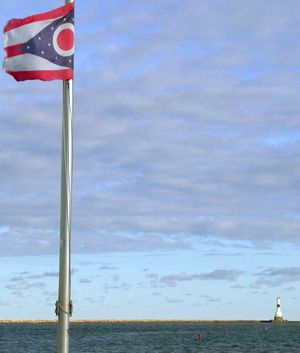
تكوِّن سهول البحيرات العظمى في شمال أوهايو جزءًا من أراضٍ خصبة منخفضة تمتد على طول البحيرات العظمى. وتتم فيها زراعة الفواكه والخضراوات.
وتعتبر سهول التيل في غرب أوهايو من بين أكثر الأراضي الزراعية خصوبة في القطر. وفي هضبة الأبلاش الوعرة توجد أجمل الأراضي حيث التلال والأودية والغابات الواسعة والشلالات. كذلك تحتوي هذه الهضبة على أكثر مناطق أوهايو ثراء بالمعادن. يوجد إقليم العشب الأزرق في أوهايو الجنوبية وهو منطقة مثلثة صغيرة ذات أراض جبلية ومتدرجة تدرجًا سهلاً.
الطقس
التسجيلات
الزلازل
أهم المدن
| الترتيب | County | التعداد | الترتيب | County | التعداد | ||||
|---|---|---|---|---|---|---|---|---|---|
 Columbus  Cleveland |
1 | Columbus | Franklin | 905,748 | 11 | Youngstown | Mahoning | 60,068 |  Cincinnati Toledo |
| 2 | Cleveland | Cuyahoga | 372,624 | 12 | Springfield | Clark | 58,662 | ||
| 3 | Cincinnati | Hamilton | 309,317 | 13 | Kettering | Montgomery | 57,862 | ||
| 4 | Toledo | Lucas | 270,871 | 14 | Elyria | Lorain | 52,656 | ||
| 5 | Akron | Summit | 190,469 | 15 | Cuyahoga Falls | Summit | 51,114 | ||
| 6 | Dayton | Montgomery | 137,644 | 16 | Middletown | Butler | 50,987 | ||
| 7 | Parma | Cuyahoga | 81,146 | 17 | Lakewood | Cuyahoga | 50,942 | ||
| 8 | Canton | Stark | 70,872 | 18 | Newark | Licking | 49,934 | ||
| 9 | Lorain | Lorain | 65,211 | 19 | Euclid | Cuyahoga | 49,692 | ||
| 10 | Hamilton | Butler | 62,082 | 20 | Dublin | Franklin | 49,328 | ||
Ohio's three largest cities are Columbus, Cleveland, and Cincinnati, all three of which anchor major metropolitan areas. Columbus is the capital of the state, located near its geographic center and is well known for Ohio State University. In 2019, the city had six corporations named to the U.S. Fortune 500 list: Alliance Data, Nationwide Mutual Insurance Company, American Electric Power, L Brands, Huntington Bancshares, and Cardinal Health in suburban Dublin.[96][97] Other major employers include hospitals (among others, Wexner Medical Center and Nationwide Children's Hospital), high tech research and development including the Battelle Memorial Institute, information-based companies such as OCLC and Chemical Abstracts Service, manufacturer Worthington Industries, and financial institutions such as JPMorgan Chase and Huntington Bancshares. Fast food chains Wendy's and White Castle are also headquartered in Columbus.
Located in Northeast Ohio along the Lake Erie shore, Cleveland is characterized by its New England heritage, ethnic immigrant cultures, and history as a major American manufacturing and healthcare center. It anchors the Cleveland–Akron–Canton Combined Statistical Area, of which the cities of Akron and Canton are constituent parts. Mansfield and Youngstown are also major cities in the region. Northeast Ohio is known for major industrial companies Goodyear Tire and Rubber and Timken, top-ranked colleges Case Western Reserve University, Oberlin College, and Kent State University, the Cleveland Clinic, and cultural attractions including the Cleveland Museum of Art, Big Five member Cleveland Orchestra, Cuyahoga Valley National Park, Playhouse Square, the Pro Football Hall of Fame, and the Rock and Roll Hall of Fame.
Cincinnati anchors Southwest Ohio and the Cincinnati Tri-State area, which also encompasses counties in the neighboring states of Kentucky and Indiana. The metropolitan area is home to Miami University and the University of Cincinnati, Cincinnati Union Terminal, Cincinnati Symphony Orchestra, and various Fortune 500 companies including Procter & Gamble, Kroger, Macy's, Inc., and Fifth Third Bank. Dayton and Springfield are located in the Miami Valley, which is home to the University of Dayton, the Dayton Ballet, and the extensive Wright-Patterson Air Force Base.
Toledo and Lima are the major cities in Northwest Ohio, an area known for its glass-making industry. It is home to Owens Corning and Owens-Illinois, two Fortune 500 corporations. Steubenville is the only metropolitan city in Appalachian Ohio, a region known for its mixed mesophytic forests.
Metropolitan areas
The Cincinnati metropolitan area extends into Kentucky and Indiana, the Steubenville metropolitan area extends into West Virginia, and the Youngstown metropolitan area extends into Pennsylvania.
Other metropolitan areas that contain cities in Ohio, but are primarily in other states include:
- Huntington-Ashland, WV-KY-OH Metropolitan Statistical Area (Lawrence County)
- Wheeling, WV-OH Metropolitan Statistical Area (Belmont County)
Additionally, 30 Ohio cities function as centers of micropolitan areas, urban clusters smaller than that of metropolitan areas. Many of these are included as part of larger combined statistical areas, as shown in the table above.
التوزيع السكانى
| التعداد تاريخياً | |||
|---|---|---|---|
| الإحصاء | التعداد | %± | |
| 1800 | 45٬365 | ||
| 1810 | 230٬760 | 408.7% | |
| 1820 | 581٬434 | 152.0% | |
| 1830 | 937٬903 | 61.3% | |
| 1840 | 1٬519٬467 | 62.0% | |
| 1850 | 1٬980٬329 | 30.3% | |
| 1860 | 2٬339٬511 | 18.1% | |
| 1870 | 2٬665٬260 | 13.9% | |
| 1880 | 3٬198٬062 | 20.0% | |
| 1890 | 3٬672٬329 | 14.8% | |
| 1900 | 4٬157٬545 | 13.2% | |
| 1910 | 4٬767٬121 | 14.7% | |
| 1920 | 5٬759٬394 | 20.8% | |
| 1930 | 6٬646٬697 | 15.4% | |
| 1940 | 6٬907٬612 | 3.9% | |
| 1950 | 7٬946٬627 | 15.0% | |
| 1960 | 9٬706٬397 | 22.1% | |
| 1970 | 10٬652٬017 | 9.7% | |
| 1980 | 10٬797٬630 | 1.4% | |
| 1990 | 10٬847٬115 | 0.5% | |
| 2000 | 11٬353٬140 | 4.7% | |
| تقديري 2008[100] | 11٬485٬910 | 1.2% | |
السكان
العرق والأصل
الدين
الإقتصاد
وتستقطب الصناعات الخدمية حوالي ثلثي عمال ولاية أوهايو. وتعتبر تجارة الجملة والتجزئة الصناعة الخدمية الرئيسية بالولاية. ويمر عبر مينائي توليدو وسينسناتي الجزء الأكبر من تجارة الجملة. وتشتمل النشاطات الأخرى من الصناعات الخدمية المهمة على الخدمات المصرفية والتعليم والرعاية الصحية والنقل.
يعتبر التصنيع النشاط الاقتصادي المهم الوحيد في الولاية، وتختلف البضائع المنتجة اختلافاً واسعًا. فهي تشتمل على قطع غيار الطائرات والآلات والسيارات وعلى الصابون والفولاذ واللدائن (البلاستيك). يعتبر الفحم والغاز الطبيعي أهم المنتجات التعدينية حيث يوجد في شرق وسط أوهايو أكبر مناجم الفحم الحجري كما يوجد الغاز الطبيعي بصورة رئيسية في الجنوب الشرقي من ولاية أوهايو.
وتوفر محاصيل الحقول معظم دخل أوهايو الزراعي. وتعد أوهايو من بين منتجي الصدارة للذرة الشامية وفول الصويا بالولايات المتحدة.
النقل
| قطار شحن يتحرك فوق مسار سكة حديد ملتوية يربط أوهايو وإنديانا في الولايات المتحدة الأمريكية |
الحكومة والقانون
accessdate = 2009-03-25}}</ref> branches.
السلطة التنفيذية
السلطة القضائية
السلطة التشريعية
السياسة القومية
| السنة | جمهوريون | ديمقراطيون |
|---|---|---|
| 2008 | 46.96% 2,674,491 | 51.50% 2,933,388 |
| 2004 | 50.81% 2,859,768 | 48.71% 2,741,167 |
| 2000 | 49.97% 2,351,209 | 46.46% 2,186,190 |
| 1996 | 41.02% 1,859,883 | 47.38% 2,148,222 |
| 1992 | 38.35% 1,894,310 | 40.18% 1,984,942 |
| 1988 | 55.00% 2,416,549 | 44.15% 1,939,629 |
| 1984 | 58.90% 2,678,560 | 40.14% 1,825,440 |
| 1980 | 51.51% 2,206,545 | 40.91% 1,752,414 |
| 1976 | 48.65% 2,000,505 | 48.92% 2,011,621 |
| 1972 | 59.63% 2,441,827 | 38.07% 1,558,889 |
| 1968 | 45.23% 1,791,014 | 42.95% 1,700,586 |
| 1964 | 37.06% 1,470,865 | 62.94% 2,498,331 |
| 1960 | 53.28% 2,217,611 | 46.72% 1,944,248 |
التعليم
الجامعات والكليات
المكاتب
الرياضة
رموز الولاية
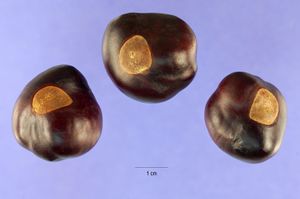
انظر أيضا
ملاحظات
- ^ "Ohio's State Motto". Ohio Historical Society. July 1, 2005. Archived from the original on October 6, 2007. Retrieved March 27, 2009.
- ^ أ ب ت ث ج ح خ د ذ ر ز "Ohio's State Symbols". Ohio Governor's Residence and State Garden. Archived from the original on April 23, 2009. Retrieved March 26, 2009.
- ^ "Ohio's State Rock Song". Ohio Historical Society. July 1, 2005. Archived from the original on February 7, 2009. Retrieved March 27, 2009.
- ^ أ ب Mary Stockwell (2006). Ohio Adventure. Gibbs Smith. p. 88. ISBN 978-1-4236-2382-3. Archived from the original on March 31, 2015. Retrieved June 16, 2015.
- ^ "The Admission of Ohio as a State". United States House of Representatives. Archived from the original on November 10, 2019. Retrieved November 10, 2019.
- ^ "Ohio Quick Facts". Ohio Historical Society. Archived from the original on February 8, 2009. Retrieved March 26, 2009.
- ^ "City of Columbus: Fun Facts". City of Columbus, Ohio. 2006. Archived from the original on May 1, 2009. Retrieved March 26, 2009.
- ^ أ ب "Elevations and Distances in the United States". United States Geological Survey. 2001. Archived from the original on July 22, 2012. Retrieved October 24, 2011.
- ^ "APPORTIONMENT POPULATION AND NUMBER OF REPRESENTATIVES BY STATE: 2020 CENSUS" (PDF). US Census Bureau. April 26, 2021. Archived (PDF) from the original on April 26, 2021. Retrieved April 26, 2021.
- ^ "Median Annual Household Income". The Henry J. Kaiser Family Foundation. Archived from the original on December 20, 2016. Retrieved December 9, 2016.
- ^ خطأ استشهاد: وسم
<ref>غير صحيح؛ لا نص تم توفيره للمراجع المسماةDNR - ^ Bureau, U.S. Census. "American FactFinder—Results". factfinder2.census.gov. Archived from the original on February 12, 2020. Retrieved October 17, 2012.
- ^ "Official USPS Abbreviations". United States Postal Service. 1998. Archived from the original on مارس 28, 2009. Retrieved مارس 26, 2009.
- ^ "Quick Facts About the State of Ohio". Ohio History Central. Archived from the original on November 27, 2010. Retrieved July 2, 2010.
From Iroquois word meaning 'great river'
- ^ "Native Ohio". American Indian Studies. Ohio State University. Archived from the original on February 2, 2007. Retrieved February 25, 2007.
Ohio comes from the Seneca (Iroquoian) ohiiyo' 'good river'
- ^ William M. Davidson (1902). A History of the United States. Scott, Foresman and Company. p. 265. Retrieved June 16, 2015.
- ^ "U.S. Gross Domestic Product (GDP), by state 2019". Statista (in الإنجليزية). Archived from the original on November 20, 2018. Retrieved December 28, 2020.
- ^ Girardi-Schachter, Taylor (2019-09-03). "Top 10 States For Manufacturing 2019". Global Trade Magazine. Retrieved December 31, 2019.
- ^ Berg-Andersson, Richard E. (2000). "The Math Behind the 2000 Census Apportionment of Representatives". The Green Papers. Archived from the original on January 6, 2009. Retrieved March 25, 2009.
- ^ Pollard, Kelvin (2008). "Swing, Bellwether, and Red and Blue States". Population Reference Bureau. Archived from the original on December 7, 2008. Retrieved March 25, 2009.
- ^ "Ohio Presidents – Ohio Secretary of State". Ohiosos.gov. Archived from the original on January 21, 2021. Retrieved December 28, 2020.
- ^ أ ب Knepper (1989), p. 9.
- ^ أ ب Knepper (1989), p. 10.
- ^ Knepper (1989), p. 11.
- ^ Douglas T. Price; Gary M. Feinman (2008). Images of the Past, 5th edition. New York: McGraw-Hill. pp. 274–277.
- ^ أ ب ت Knepper (1989), p. 13.
- ^ "Monongahela culture-AD 1050–1635". Fort Hill Archeology. Retrieved January 14, 2010.
- ^ Knepper (1989), p. 14.
- ^ Roseboom (1967), p. 20.
- ^ louis, franquelin, jean baptiste. "Franquelin's map of Louisiana". LOC.gov. Retrieved August 17, 2017.
- ^ Knepper (1989), pp. 14–17.
- ^ Knepper (1989), pp. 43–44.
- ^ "American Indians - Ohio History Central". ohiohistorycentral.org. Archived from the original on December 29, 2020. Retrieved February 23, 2021.
- ^ "Wars and Battles: Treaty of Paris (1763)". www.u-s-history.com. Archived from the original on December 4, 2015. Retrieved March 9, 2022.
- ^ Billington, Ray A. (1944). The Fort Stanwix Treaty of 1768 from New York History. University of Nebraska Press. pp. 182–194. JSTOR 23147791. Archived from the original on March 9, 2022. Retrieved March 9, 2022.
- ^ Sosin, Jack M. (1961). Whitehall and the wilderness: the Middle West in British colonial policy, 1760–1775. Cornell University Press. p. 146. Archived from the original on January 18, 2020. Retrieved March 9, 2022.
- ^ White, Richard (1991). The Middle Ground: Indians, Empires, and Republics in the Great Lakes Region, 1650–1815. Cambridge University Press. p. 256. ISBN 0-521-42460-7.
- ^ Gerald E. Hart (1891). The Quebec Act 1774. Montreal: Gazette Printing Company. p. 12.
- ^ Gordon Wood, The American Revolution (New York: Random House, 2002).
- ^ Downes, Council Fires, 211; Nester, Frontier War, 194; Nelson, Man of Distinction, 101.
- ^ Downes, Council Fires, 266.
- ^ Keller, Christine; Boyd, Colleen; Groover, Mark; Hill, Mark (2011). "Archeology of the Battles of Fort Recovery, Mercer County, Ohio: Education and Protection" (PDF). National Park Service American Battlefield Protection Program. p. 61. Archived (PDF) from the original on June 12, 2019. Retrieved November 24, 2019 – via Ball State University.
- ^ Weslager, Delaware Indians, 316.
- ^ Sterner, Eric (February 6, 2018). "Moravians in the Middle: the Gnadenhutten Massacre". Journal of the American Revolution. Archived from the original on September 30, 2019. Retrieved September 30, 2019.
- ^ Cogliano, Francis D. (2003). Revolutionary America, 1763–1815: A Political History. Francis and Taylor. ISBN 978-1-1346-7869-3. Archived from the original on February 20, 2021. Retrieved November 19, 2020.
- ^ Kaplan, Lawrence S. (September 1983). "The Treaty of Paris, 1783: A Historiographical Challenge". International History Review. Taylor & Francis, Ltd. 5 (3): 431–442. doi:10.1080/07075332.1983.9640322. JSTOR 40105317.
- ^ Cayton (2002), p. 3.
- ^ "Religion and the Congress of the Confederation, 1774–89". Library of Congress. June 4, 1998. Archived from the original on May 2, 2012. Retrieved April 11, 2012.
- ^ Hubbard, Robert Ernest. General Rufus Putnam: George Washington's Chief Military Engineer and the "Father of Ohio," pp. 1–4, McFarland & Company, Inc., Jefferson, North Carolina. ISBN 978-1-4766-7862-7.
- ^ Hubbard, Robert Ernest. General Rufus Putnam: George Washington's Chief Military Engineer and the "Father of Ohio," pp. 2–4, 45–8,105–18, McFarland & Company, Inc., Jefferson, North Carolina. ISBN 978-1-4766-7862-7.
- ^ Hildreth, Samuel Prescott. Biographical and Historical Memoirs of the Early Pioneer Settlers of Ohio, pp. 34–7, 63–74, Badgley Publishing Company, 2011. ISBN 978-0615501895.
- ^ McCullough, David. The Pioneers: The Heroic Story of the Settlers Who Brought the American Ideal West, pp. 46–7, Simon & Schuster, Inc., New York, New York, 2019. ISBN 978-1-5011-6870-3.
- ^ Hubbard, Robert Ernest. General Rufus Putnam: George Washington's Chief Military Engineer and the "Father of Ohio," pp. 127–50, McFarland & Company, Inc., Jefferson, North Carolina. ISBN 978-1-4766-7862-7.
- ^ Hildreth, Samuel Prescott. Biographical and Historical Memoirs of the Early Pioneer Settlers of Ohio, pp. 69, 71, 81, 82, Badgley Publishing Company, 2011. ISBN 978-0615501895.
- ^ McCullough, David. The Pioneers: The Heroic Story of the Settlers Who Brought the American Ideal West, pp. 143–7, Simon & Schuster, Inc., New York, New York, 2019. ISBN 978-1-5011-6870-3.
- ^ An act to provide for the due execution of the laws of the United States, within the state of Ohio, ch. 7, 2 Stat. 201 (February 19, 1803).
- ^ أ ب Blue, Frederick J. (Autumn 2002). "The Date of Ohio Statehood". Ohio Academy of History Newsletter. Archived from the original on September 11, 2010.
- ^ Joint Resolution for admitting the State of Ohio into the Union, (Pub.L. 83–204، 67 Stat. 407، enacted أغسطس 7، 1953).
- ^ "Clearing up the Confusion surrounding OHIO's Admission to Statehood". Archived from the original on October 17, 2009. Retrieved October 30, 2009.
- ^ "The Shawnee Tribe & War of 1812". Archived from the original on February 25, 2022. Retrieved February 25, 2022.
- ^ Stockwell, Mary (2014). The Other Trail of Tears: The Removal of the Ohio Indians.
- ^ "What happened to Indians that once inhabited Ohio? - Columns by Jim Blount". Archived from the original on February 25, 2022. Retrieved February 25, 2022.
- ^ Knepper (1989), pp. 233–234.
- ^ Roseboom and Weisenburger (1967), p. 188.
- ^ "Morgan's Raid—Ohio History Central". Ohiohistorycentral.org. Archived from the original on June 21, 2018. Retrieved April 2, 2018.
- ^ Cayton (2002), p. 129.
- ^ Cayton (2002), pp. 128–129.
- ^ أ ب ت "History of Ohio Steelmaking". OhioSteel.org. Archived from the original on July 25, 2010. Retrieved August 17, 2017.
- ^ "Ohio's State Flag (1901)". Ohio History Central. Archived from the original on February 21, 2022. Retrieved February 21, 2022.
- ^ "The Wright Brothers - The First Successful Airplane". National Air and Space Museum. Archived from the original on February 21, 2022. Retrieved February 21, 2022.
- ^ "1913 Ohio Statewide Flood". Ohio History Central. Archived from the original on February 21, 2022. Retrieved February 21, 2022.
- ^ "Timeline Detail | Pro Football Hall of Fame Official Site". Archived from the original on September 15, 2018. Retrieved September 14, 2018.
- ^ "Triangle Park: Site of First Game In The NFL". Archived from the original on February 21, 2022. Retrieved February 21, 2022.
- ^ Maroon, Thomas; Maroon, Margaret; Holbert, Craig (2006). Akron-Canton Football Heritage. Arcadia Publishing. ISBN 9780738540788. Archived from the original on January 7, 2022. Retrieved January 5, 2022.
- ^ أ ب "Great Depression". Ohio History Central. Archived from the original on February 21, 2022. Retrieved February 21, 2022.
- ^ Bytwerk, Randall. "The SS and Superman". Calvin.edu. Archived from the original on June 26, 2015. Retrieved August 17, 2017.
- ^ "The religion of Superman (Clark Kent / Kal-El)". Adherents.com. Archived from the original on May 21, 2009. Retrieved August 17, 2017.
{{cite web}}: CS1 maint: unfit URL (link) - ^ "1913 Ohio Statewide Flood". World War II. Archived from the original on February 21, 2022. Retrieved February 21, 2022.
- ^ "Carl B. Stokes". Ohio History Central. Archived from the original on February 21, 2022. Retrieved February 21, 2022.
- ^ Hildebrand, Herrington, & Keller; pp. 165–166
- ^ "Ohio Fuel Cell Symposium 2010". GCBL.org. 2010. Archived from the original on July 26, 2011. Retrieved August 17, 2017.
- ^ Woody, Todd (November 23, 2009). "Solar energy industry brings a ray of hope to the Rust Belt". Archived from the original on April 17, 2017. Retrieved August 17, 2017 – via LA Times.
- ^ "Biden flies to Akron to help governor". Ohio.com. Archived from the original on June 15, 2011. Retrieved August 17, 2017.
- ^ "Ohio Third Frontier – History". Ohio.gov. Archived from the original on October 6, 2010. Retrieved August 17, 2017.
- ^ "Ohio can't afford to kill Third Frontier: Brent Larkin". Cleveland.com. May 2, 2010. Archived from the original on August 18, 2017. Retrieved August 17, 2017.
- ^ أ ب "Ohio Third Frontier Continues to Create Jobs and Opportunities for Ohioans". PRNewswire (Press release). Ohio Business Development Coalition. Archived from the original on August 18, 2017. Retrieved August 17, 2017.
- ^ "Ohio Third Frontier and Supporting Programs Win Top Tech Awards for Economic Development". Digital Journal (Press release). Archived from the original on August 18, 2017. Retrieved August 17, 2017.
- ^ أ ب "Atlantic Eye: Brunner is the best for Ohio" Archived أغسطس 5, 2010 at the Wayback Machine, Marc S. Ellenbogen. May 3, 2010. Retrieved May 5, 2010.
- ^ ""Five cities that will rise in the New Economy", Christian Science Monitor. Retrieved November 27, 2009". Christian Science Monitor. November 20, 2009. Archived from the original on November 23, 2009. Retrieved February 14, 2021.
- ^ "Ohio gov. declares NW Ohio a solar energy hub". ABCLocal.go.com. June 30, 2010. Archived from the original on July 6, 2010. Retrieved August 17, 2017.
- ^ "Ohio has endured decade of job losses". Dispatch.com. September 12, 2010. Archived from the original on October 5, 2010. Retrieved August 17, 2017.
- ^ Grzegorek, Vince (May 20, 2010). "We're Number One: Cuyahoga Leads Ohio Foreclosures... Again". CleveScene.com. Archived from the original on August 18, 2017. Retrieved August 17, 2017.
- ^ "Ohio's poverty, uninsured rates up; median income drops sharply". Cleveland.com. September 2010. Archived from the original on August 18, 2017. Retrieved August 17, 2017.
- ^ أ ب Ohio Facts 2016: Ohio's Economy Ranks 7th Largest Among States Archived يناير 31, 2017 at the Wayback Machine, Ohio Legislative Service Commission.
- ^ "U.S. Census Bureau QuickFacts". Archived from the original on February 2, 2022. Retrieved February 3, 2022.
- ^ "Top 100 U.S. metro economies" (PDF). U.S. Conference of Mayors. Archived from the original (PDF) on June 25, 2010. Retrieved April 22, 2010.
- ^ Womack, Brian (June 10, 2019). "Plano set to lose Fortune 500 HQ as Alliance Data Systems shifts to Ohio". Dallas Business Journal. Archived from the original on November 25, 2020. Retrieved August 19, 2021.
- ^ أ ب "OMB Bulletin No. 17-01: Revised Delineations of Metropolitan Statistical Areas, Micropolitan Statistical Areas, and Combined Statistical Areas, and Guidance on Uses of the Delineations of These Areas" (PDF). United States Office of Management and Budget. August 15, 2017. Archived (PDF) from the original on January 21, 2019. Retrieved March 6, 2018.
- ^ أ ب ت ث "2020 Population and Housing State Data". United States Census Bureau, Population Division. August 12, 2021. Archived from the original on August 24, 2021. Retrieved August 14, 2021.
- ^ خطأ استشهاد: وسم
<ref>غير صحيح؛ لا نص تم توفيره للمراجع المسماة08CenEst - ^ Akron & Summit County History:Police
المصادر
- الموسوعة المعرفية الشاملة
- Cayton, Andrew R. L. (2002). Ohio: The History of a People. Columbus, OH: The Ohio State University Press. ISBN 0814208991
- Knepper, George W. (1989). Ohio and Its People. Kent, OH: Kent State University Press. ISBN 978-0873387910
- Mithun, Marianne (1999). Languages of Native North America. Cambridge, UK: Cambridge University Press.
- Morris, Roy, Jr. (1992). Sheridan: The Life and Wars of General Phil Sheridan. New York: Crown Publishing. ISBN 0-517-58070-5.
- Holli, Melvin G. (1999). The American Mayor. State College, PA: Pennsylvania State University Press. ISBN 0271018763
- Roseboom, Eugene H.; Weisenburger, Francis P. (1967). A History of Ohio. Columbus: The Ohio Historical Society.
وصلات خارجية
- Ohio Department of Natural Resources
- Ohio Earthquake Information
- Ohio State Facts
- State of Ohio Official Website
- Ohio Sunshine Wiki
- State of Ohio wiki
- U.S. Census Bureau (Ohio Quick Facts)
- USGS real-time, geographic, and other scientific resources of Ohio
- أوهايو at the Open Directory Project

|
بحيري إيري | مشيگن | 
| |
| پنسلڤانيا | إنديانا | |||
| وست ڤرجينيا | كنتكي |
![]() الولايات المتحدة
قالب:OH cities and mayors of 100,000 population
الولايات المتحدة
قالب:OH cities and mayors of 100,000 population
| سبقه تنسي |
قائمة الولايات الأمريكية حسب تاريخ إشهار الولاية | تبعه لويزيانا |
40°30′N 82°30′W / 40.5°N 82.5°W
خطأ استشهاد: وسوم <ref> موجودة لمجموعة اسمها "lower-alpha"، ولكن لم يتم العثور على وسم <references group="lower-alpha"/>
- CS1 maint: unfit URL
- Pages using gadget WikiMiniAtlas
- Short description matches Wikidata
- Short description is different from Wikidata
- Pages using infobox settlement with possible nickname list
- Pages using infobox settlement with possible motto list
- Pages using infobox settlement with no coordinates
- Articles containing Seneca-language text
- مقالات فيها عبارات متقادمة منذ 2019
- جميع المقالات التي فيها عبارات متقادمة
- Articles with hatnote templates targeting a nonexistent page
- مقالات ذات عبارات محل شك
- جميع الصفحات التي تحتاج تنظيف
- مقالات بالمعرفة تحتاج توضيح from January 2019
- Pages with empty portal template
- Coordinates on Wikidata
- أوهايو
- ولايات أمريكية
- ولايات الغرب الأوسط
- دول وأراضي تأسست في 1803

